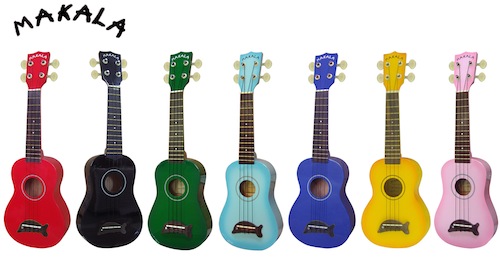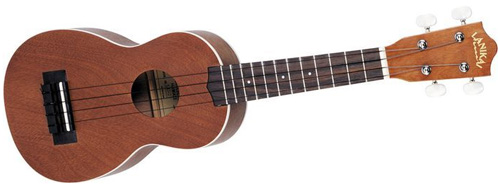Chances are if you’re waiting for motivation to come, then, you might find yourself at the end of your life wondering why you didn’t learn to play an instrument.
A lot of us have had this experience at some point in our lives where we set out to change our lifestyle for the better, like exercising or eating more veggies, only to find ourselves three months later in the same exact spot.
Learning to play ukulele can be similar.
You know you love music.
You know you have a passion for music.
You know you’ve always had a dream to play an instrument.
Then, why is it so hard? Why haven’t you done it yet? Why is it the first thing that slips away when life gets busy?
Before you start beating yourself up, consider you aren’t the only one to have fought to find the time, energy and motivation to make music in your busy life.
The Power of Habit
Many people think if they were true musicians or ukulele players or really had a love for music then it’d just be apart of their every day life.
This is true for some, but for the rest of us, time has a way of slipping away and life gets busy.
Some will even say you need more willpower or a stronger desire to learn.
But what if becoming a musical person, where you regularly play, practice and make music, is a part of your everyday life? It’s just who you are. What if it’s not about just waking up one day magically having more willpower?
This is why habits are so powerful.
A ukulele habit is the wind in your sails when motivation wanes, when willpower is nowhere to be found, and when you just don’t feel like practicing. This habit is what gives you the momentum to progress and grow in your skills. It’s what makes you known as the musical person in your group of friends or family.
A Brief Science of Habits
Building a habit like playing ukulele every day isn’t random.
This means if you’re hoping to one day wake up with the motivation to practice then you’ll probably be disappointed.
I was first introduced to a framework for building habits in James Clear’s essay The 3 R’s of Habit Change where he unpacks Stanford Professor BJ Fogg’s process of habit formation.
To create a habit, you must have the following:
- Reminder (the trigger that initiates the behavior)
- Routine (the behavior itself; the action you take)
- Reward (the benefit you gain from doing the behavior)
Let’s use this framework to build a ukulele habit.
1. Anchoring and a Ukulele For Every Room
Most likely you already have a set of your own already established daily habits:
- Waking up
- Brushing your teeth
- Showering
- Eating meals
- Taking breaks at work
- Watching TV
- Exercising
- Checking your email
You can use any of your already established daily habits to anchor your ukulele practice.
Remember our ukulele habit needs a trigger or a reminder that spurs us to take action. For example, the daily act of drinking your cup of coffee becomes the reminder for you to play ukulele. The notification set on your phone reminds you to practice. Your lunch break at work is the time to fit in a quick practice session.
To make it easier, think about your daily habits and anchor your ukulele habit to an already established one.
Don’t forget your environment can offer you powerful reminders or triggers to play and practice ukulele too.
For example, are your more or less likely to eat a cookie if the cookie jar is sitting out in the open on the table, or if it’s buried behind the box of cereal in the pantry? Unless you’re the perfect embodiment of self-control and restraint, I’ll eat cookies all day if they’re left in the open!
Likewise, how likely would you be to play if you had a ukulele in every room of your house?
A ukulele sitting out on a stand right next to your desk or sofa is more likely to be played than a ukulele locked in a case underneath a pile of clothes in your bedroom closet.
This is why I always have a ukulele sitting out in a stand by my desk within an arms reach. When I get bored (or wish to procrastinate on my work!), I can easily pick up the ukulele and strum a few chords.
Now, of course, you don’t have to buy ten ukuleles for every room of your house (although you wouldn’t be the first one!), but why not grab a gig bag that allows you to carry your ukulele with you anywhere you go? That’s a great way to always have your ukulele with you to create a powerful trigger to pick up and play throughout your day.
2. Practicing Little
Creating a habit like playing ukulele can be fun!
It’s not all serious, scientific business.
This is why it’s important you don’t have a marathon practice session when you sit down to play.
A lot of us say, “I don’t have the time,” but you don’t have to spend hours practicing and you shouldn’t.
Eighty percent of success is showing up.
In the early stages, practice as a little as possible.
To build the habit of playing ukulele, start small.
New players make the mistake thinking they have to practice hours each day until their fingers feel like falling off.
Instead of practicing until you can’t move your fingers, a better practice routine would be:
For one minute, practice one chord, and then, put down the ukulele and walk away.
Yes. That’s all!
This is all about finding your momentum and making the action of practicing ukulele (routine) as easy as possible.
Admittedly, it can be difficult to even know what to practice when you do find the time. If this is you, then, you have every reason to join me in the free Learn To Play Ukulele Today email course or in Club Ukulele where I show you exactly what to practice.
Upon practicing, check it off or draw an “X” on your calendar to visualize and see the momentum build.
Remember playing ukulele is a marathon not a sprint. Of course you can play as long as you want but the idea here is to set a habit you can regularly include in your life. Ideally you want music to be apart of the rest of your life not just something you do for the summer and then quit.
By starting small you build your ukulele habit and allow momentum to take over!
3. Rewarding Yourself
So far, you’ve created a reminder and routine.
The final piece of building a habit, like playing ukulele every day, is to reward yourself.
A lot of us miss out on this important piece of the puzzle.
Perhaps we refuse to reward ourselves because we’re hard on ourselves. Perhaps we have this idea in our minds that says learning a new skill like ukulele is all about “grit” and “hustle” and no fun.
The why we don’t reward ourselves isn’t critical to figure out, but to build a successful habit we do need to find ways to reward our efforts. So, what does it mean to reward ourselves for playing ukulele?
No doubt there are a lot of intrinsic reward in playing ukulele. Intrinsic, meaning, you enjoy playing ukulele for the sake of playing ukulele.
Examples of intrinsic motivators include:
- Adrenaline. The thrill and rush of endorphins you get from playing ukulele in front of a group of people.
- Social connection. The feeling of laughing with a group of ukulele players as you fumble your way through playing a song.
- Pain relief. The mental, physical or emotional relief you feel when you strum your ukulele.
- Personal satisfaction and identity. The satisfaction of becoming the musical person you want to be.
- Memories and emotional connection. The memories evoked when you strum and play a familiar song from your childhood.
- Individual choice. The feeling of choice and ownership when you set out to learn a new song that inspires you.
Each of these motivators is a tremendous reward we experience physically and mentally from playing the ukulele. Wouldn’t it be amazing if these intrinsic motivators were existent every time we picked up the ukulele? Sadly, this isn’t always the case!
The kind of practice that develops your skills is rarely in and of itself intrinsically motivating.
For practice to be the most effective, practice requires you to sit and focus on developing a skill through repetition.
It’s like a basketball player who runs drills over and over again or shoots a hundred free throws one after the other in practice. This player is building the muscle memory and repetition required to perform when it matters most on the field of play.
In this way, practice relies on extrinsic motivators.
This means you have to look beyond the practice for your motivation. It means answering the question of:
What would it mean for me to put in the practice?
For example, the extrinsic motivator to practice might be to be able to successfully perform a song for a friend’s birthday. Your motivated to practice because of your friend. The reward comes when you finally perform the song for your friend and have a successful performance.
Simply put, practice in and of itself is rarely rewarding. You have to look beyond your practice like being able to play a song for a friend. Still though, to develop a ukulele habit, you must reward yourself immediately after your practice in some small way.
Right after practicing, you might:
- Eat a piece of chocolate
- Watch an episode of your favorite TV show
- Check social media
- Physically draw a check mark on your calendar
- Play a game on your phone
Think about what’s rewarding to you. Your reward should be short and simple.
Initially, a fast, quick reward helps provide the reinforcement we need to perform the routine again the next day. By combining a reminder, a short practice routine, and a quick reward, you start to develop a ukulele practice habit that finds itself soon taken over by momentum.
When momentum kicks in, you might begin to find that practice becomes more intrinsically rewarding where you begin to look forward to practicing because of what you’ll discover. Students who embrace an attitude of curiosity often find they enjoy practice more. In this way, practice can develop into more of a reward.
Additionally, because of the investment you’ve made into your practice habit, you’re more easily able to play the songs you love. You’re able to play confidently with your ukulele group. Your ukulele habit means you find these activities more rewarding and fun! For example, you’re not worried about messing up during your ukulele group but can sit back, relax and enjoy making music. All of this has the ability compound in making you actually look forward to that next practice session because of what you’ll learn next.
Will You Develop a Ukulele Habit?
There are many reasons why you would want to create a ukulele practice habit, including:
- Becoming a musical person
- Confidently playing with your ukulele group for social connection
- Finding relief from physical, mental or emotional pain
- Experiencing the thrill of performing for others
- Being able to play the songs you love
… and much more.
To do build your ukulele habit, use the power of science and psychology to create a reminder, routine, and reward that is short, simple and sweet!
But remember:
Keep it simple!
Don’t overcomplicate the three “R’s” of building a habit.
A reminder is as simple as putting it on your calendar. A practice routine is as simple as practicing one chord for a minute. A reward is as simple as eating a piece of candy after completing your routine.
A minute today is all that is required to start building your ukulele habit!
To help find your routine and to know exactly what to practice to play the music you love, join me in Club Ukulele – a monthly membership where you get fresh new ukulele lessons each month all for you to go at your own pace in multiple styles.
Start building your ukulele habit with Club Ukulele today.


























































 Working on the song "My Hawaiian Sunshine" in this video. Because I'm playing the song in Bb, the barre chords with simple down strums give it a nice muted feel that opens with fuller strumming in the chorus. One of the benefits of working on your barre chords! What are your favorite songs to play on ukulele in the summer?
Working on the song "My Hawaiian Sunshine" in this video. Because I'm playing the song in Bb, the barre chords with simple down strums give it a nice muted feel that opens with fuller strumming in the chorus. One of the benefits of working on your barre chords! What are your favorite songs to play on ukulele in the summer?






